 May 2022
In some Native languages the term "plants" translates to
"those who take care of us."
Quote from Braiding Sweetgrass by Robin Wall Kimmerer, mother, scientist, decorated professor, and enrolled member of the Citizen Potawatomi Nation.
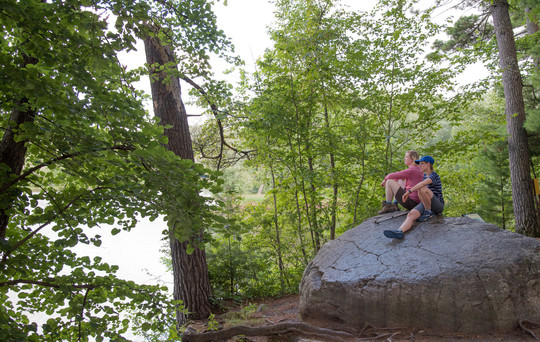 William O'Brien State Park provides a beautiful setting for quality recreation along the banks of the St. Croix River.
Established in 1949, the goal of this month's designation is "to increase awareness of the importance of mental health and wellness in Americans' lives, and to celebrate recovery from mental illness." Life has been extra challenging the past couple of years and our collective resilience has been tested. Natural spaces have provided a respite... and there's a science to it.

Smells, sounds, exercise, and even patterns have demonstrated a positive impact on the human brain, fostering relaxation, mood improvement and even an increase in creativity and focus. The Attention Restoration Theory (ART) proposes that exposure to nature can also help us improve our focus and ability to concentrate. As little as ten minutes in nature can allow the analytical side of the brain to rest, while the sensory side is stimulated, as we're alert to environmental conditions.
When we're back to our daily lives (be it work, school or home), the analytical side of the brain kicks back in, but now is more focused and creative from having rested. We're calmer and our creativity, problem-solving, communications and social skills are enhanced. The more time spent outdoors, the longer the mental impacts last.
Find out about different ways outdoor recreation can help with your mental health... then gift yourself some time outside surrounded by "those who take care of us."
PHOTO: Aromatic prairie onion flower by Kelly Povo
|


 Trails at Franz Jevne State Park wander through a mixed forest including jack pine and birch. Stately white pines frame wonderful views of the Rainy River. Pine, cedar, spruce and fir are some of the best phytoncide producers. PICTURED BELOW, the wild bergamot flower. An excellent garden plant, bergamot is aromatic, and its oils have been used in natural healing for centuries. PHOTO: Kelly Povo
BREATHE: Some plants and trees emit chemicals into the air that boost immune function and wellbeing.
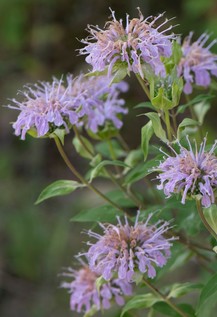
Forest bathing is a Japanese practice of walking slowly and mindfully in nature, using your five senses to “soak” in the ambiance of the forest. Forest plants and trees emit phytoncides, natural oils they use to defend themselves against pests. Phytoncides improve the human immune system by increasing activity of natural killer cells, the cells that respond to virus-infected cells and tumor formation. This effect can last more than 30 days after time in the forest! Phytoncides help increase anti-cancer proteins, and reduce blood pressure, heart rate and stress hormones, as well as anxiety, depression, anger, fatigue, and confusion.
Prairie flowers such as wild bergamot (pictured), hyssop, wild onion and prairie rose produce pleasant aromatic fragrances that can boost mental wellbeing.
More on the benefits of phytoncides and forest bathing from the U.S. Forest Service and the National Library of Medicine. Keep an eye out for programs lead by certified forest bathing naturalist Sara Holger at Whitewater State Park.
|
LOOK: The fractal patterns echoed throughout the natural world are calming to the human mind.
 Hang a hammock in the woods and relax observing the cool fractal patterns all around you. PHOTO: Matt Kilanowski
Fractals are patterns that self-repeat at different scales, and they can be found all over nature in objects like trees, rivers, clouds and coastlines. Because of their prevalence, our brains have evolved to respond positively to fractals. Research shows that fractals reduce stress and mental fatigue for observers.
Read more about the science behind the positive response induced by nature from Around the O (University of Oregon).
HEAR: Natural sounds improve health, increase positive affect, and lower stress and annoyance.
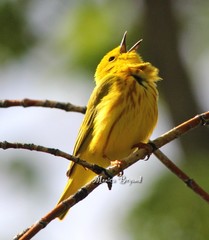
According to a recent study, of the three types of natural sounds (birds, water, and mixed), the sounds of water were most effective at improving positive emotions and health outcomes. Bird sounds are shown to be the best to help combat stress and annoyance.
More on the study on nature sounds conducted by the National Park Service Colorado State University, Canada’s Carleton University and Michigan State University from EverydayHealth.com and the Smithsonian Magazine.
PHOTO: Yellow warbler by Monica Bryand. Frontenac State Park boasts the most bird species of any Minnesota state park, and is tops for warblers! Use the nifty interactive bird poster from Minnesota Conservation Volunteer magazine to identify the different species by ear.
|
FEEL: The sight and sound of water can induce a flood of neurochemicals that increase blood flow to the brain and heart and help with relaxation.
 Many landings along the St. Louis River Estuary National Water Trail provide access to parks, food and drinking water. Year-round recreation opportunities such as fishing, birding, camping, skijoring and biking are great ways to connect people to natural spaces and foster new relationships with the river.
It's not just for practical reasons that our communities are located by water. Humans are naturally drawn to water. Almost all of our senses are engaged when we're in and by water. Being in or by water can improve our mood and counter the negative effects of too much time inside in front of a computer.
A lot more about "blue mind science" from Quartz.


Dr. Mollika Sajady promotes health outcomes through nature and mindfulness experiences.
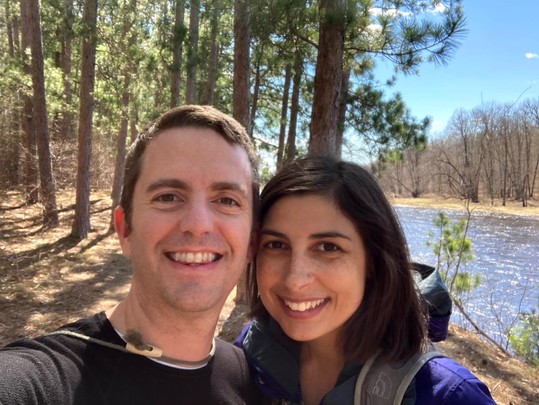 "We started exploring new state parks during the pandemic. We did a pretty long day hike at St. Croix State Park and it was the most amazing day!" Below, Dr. Sajady with her two young kids and husband enjoying a day out at Mille Lacs Kathio State Park. PHOTOS: Dr. Mollika Sajady
I'm a Developmental Behavior Pediatrician, specialized in developmental differences and complex care needs, such as Attention Deficit Hyperactive Disorder (ADHD) and Autism. In my personal time, I enjoy hiking and cycling — road and mountain biking — with my husband, and sometimes even with our kids in tow in the bike trailer.
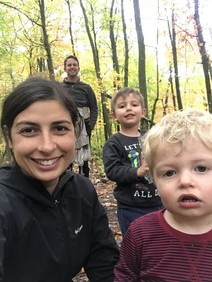
My passion for helping others discover the impact of spending time in nature for health and wellness has been inspired by personal experiences. My husband and I went to the Boundary Waters Canoe Area after we got married and it was a very restorative and helpful experience, as I was doing an intense residency training at the time. After that trip, we both agreed we were going to make wilderness vacations a priority and try to inspire others to do the same.
For me, the most important reason to get out in nature is for stress relief. Throughout the day, our minds are busy focusing and using organizational functions, kind of like a computer, to accomplish many tasks. By going outside, we can give our minds a break, as our body has an innately restorative response when we're in nature. This break is like a reset button that helps us be more engaged when we return to our daily activities.
You don't have to wait for that big vacation in the wilderness, though. You can spend time in nature daily! Find something really small and enjoyable to get started. Sit outside by a couple of plants or find some "green" right outside your door. You take a break and these small doses and tiny exposures can help reset the mind and body.
|

Karen mom, author and outdoors woman
 "I don't have a favorite state park or trail because they all are different in their own way. I prefer state parks with some terrain, and I like chasing waterfalls." Remona pictured at Gooseberry Falls State Park in the winter. Below, Remona sharing healing time outdoors with her daughter at Afton State Park. PHOTOS: Remona Htoo
I grew up in an unhealthy environment, and with that, I had a lot of personal trauma growing up. For a long time, I didn't know who to talk to or even know how to begin my healing journey. I started to go for walks when I felt overwhelmed or anxious. First, I walked along the Mississippi River and, when I learned how to drive, I drove away from the city to hike. Hiking through pine trees, dirt trails, and hills surrounded by nature was my form of therapy. Hiking is my favorite outdoor activity as I feel like I can pay attention to more details.
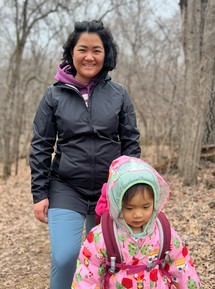
After I gave birth and went through postpartum depression, I hiked more than ever before. I took my daughter with me and carried her on my back. It was good for both of us. Now that she's walking, I enjoy watching her explore her surroundings. I love raising my daughter in the outdoors. It's important to me to teach my daughter that we're connected with nature.
The outdoors is a space for everyone. Mother nature doesn't discriminate, and it doesn't care about the color of your skin. So come as you are and be yourself. It can be scary for some to be in a space where you feel unwelcome. I felt that way when I first began hiking, as I didn't see anyone that looked like me on the trail. Most people I saw were white, and I felt that I was in their space.
But again, Mother Earth reminded me that I belong. It didn't matter that I was a refugee seeking refuge, I have the right to feel at ease when I'm in the great outdoors. It's crucial for me to teach my daughter the same thing... so I wrote her a book about what her little legs can do outdoors and through different seasons.
You too can find your own therapy in the outdoors. Be like Remona and her daughter and go find out what your legs can do outdoors. Follow their adventures on Instagram.
|
|